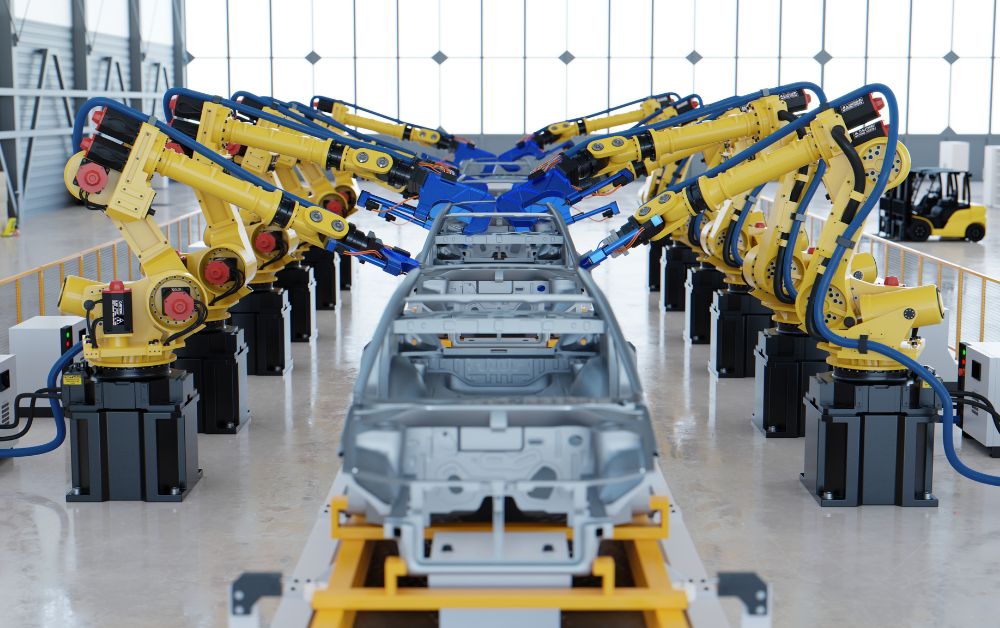Revolutionizing the Road: How IoT is Transforming the Automotive Industry

The automotive industry is in the midst of a profound transformation, driven by the convergence of technology and transportation. One of the key drivers of this transformation is the Internet of Things (IoT), which is revolutionizing how vehicles are designed, manufactured, operated, and maintained. In this comprehensive blog, we will delve deep into the world of IoT and explore how it is transforming the automotive industry.
Understanding IoT in Automotive
What is IoT?
The Internet of Things, or IoT, refers to a network of interconnected physical objects or “things” that can collect, exchange, and process data over the internet without human intervention. These objects are embedded with sensors, software, and other technologies to enable them to communicate and share data.
IoT in the context of the automotive industry
In the automotive industry, IoT encompasses a wide range of applications and technologies that leverage connectivity and data exchange to improve vehicles’ functionality, safety, and efficiency. This includes everything from connected vehicles and smart manufacturing processes to enhanced driver experiences and sustainable transportation solutions.
Connected Vehicles
The rise of connected cars
Connected vehicles are a prominent example of IoT’s impact on the automotive industry. These cars are equipped with sensors, internet connectivity, and onboard computers that enable them to communicate with other vehicles, infrastructure, and cloud-based platforms.
Benefits of connected vehicles
- Real-time data: Connected cars can provide real-time data on traffic conditions, weather, and road hazards, allowing drivers to make informed decisions.
- Remote diagnostics: Manufacturers can remotely monitor vehicle performance and provide over-the-air updates, reducing the need for physical recalls.
- Enhanced safety: Connected vehicles can communicate with each other to avoid collisions and warn drivers of potential dangers.
- Efficient navigation: GPS and traffic data can be used to optimize routes, saving time and fuel.
- Entertainment and convenience: Infotainment systems, streaming services, and smartphone integration enhance the driver and passenger experience.
Examples of connected car features
- Automatic emergency braking: Sensors detect obstacles and apply the brakes if the driver doesn’t react in time.
- Vehicle-to-vehicle (V2V) communication: Cars share information about speed, location, and direction to prevent accidents.
- Remote start and climate control: Drivers can start their cars and adjust the climate remotely via a smartphone app.
- Advanced driver assistance systems (ADAS): Lane-keeping assistance, adaptive cruise control, and parking assistance rely on IoT sensors.
- Fleet management: Companies can track the location and status of their vehicles, improving efficiency and security.
IoT in Vehicle Manufacturing
Smart factories and Industry 4.0
IoT has revolutionized the manufacturing process in the automotive industry. Smart factories, often referred to as Industry 4.0, use IoT technologies to create highly efficient and automated production lines.
IoT-enabled production lines
- Predictive maintenance: Sensors monitor equipment in real-time, detecting signs of wear and tear, and scheduling maintenance before breakdowns occur.
- Inventory management: IoT systems track inventory levels, automatically reordering parts and materials when needed.
- Quality control: Cameras and sensors inspect components for defects, ensuring a higher level of quality.
- Energy efficiency: Smart factories optimize energy usage, reducing costs and environmental impact.
Quality control and predictive maintenance
Predictive maintenance, made possible by IoT sensors and data analysis, has significantly reduced downtime in automotive manufacturing. By monitoring equipment and machines in real time, manufacturers can identify potential issues and schedule maintenance before a breakdown occurs. This not only reduces costly disruptions but also improves overall production efficiency.
Enhancing Vehicle Safety
Real-time monitoring and alerts
Connected vehicles are equipped with various sensors and cameras that continuously monitor the vehicle’s surroundings. This real-time data is used to provide alerts and warnings to drivers, helping to prevent accidents.
Collision avoidance systems
IoT plays a crucial role in collision avoidance systems, which use sensors to detect potential collisions and take action to prevent them. For example, adaptive cruise control adjusts the vehicle’s speed to maintain a safe following distance, while automatic emergency braking can apply the brakes if a collision is imminent.
IoT’s role in autonomous vehicles
Autonomous vehicles, which rely on IoT technologies for navigation, communication, and sensor fusion, are a prime example of IoT’s impact on vehicle safety. These vehicles use a combination of sensors, including LiDAR, radar, and cameras, to perceive their surroundings and make real-time decisions to navigate safely.
Improving Driver Experience
Infotainment systems
IoT has transformed the in-car entertainment experience. Infotainment systems provide a wide range of features, including touchscreen displays, voice recognition, smartphone integration, and internet connectivity. Drivers and passengers can access music, navigation, apps, and more from the comfort of their vehicles.
Personalization and user preferences
Connected vehicles can store and analyze data about driver behavior and preferences. This information can be used to customize the driving experience, from adjusting seat positions and climate control settings to recommending nearby restaurants and gas stations.
Voice recognition and AI assistants
IoT-powered voice recognition systems and AI assistants, such as Amazon Alexa and Google Assistant, allow drivers to control various functions in their cars using voice commands. This hands-free interaction enhances safety and convenience on the road.
IoT in Fleet Management
Telematics and asset tracking
Fleet management has been greatly improved by IoT technologies. Telematics systems, which combine GPS, cellular communication, and onboard sensors, enable companies to track the location, speed, and status of their vehicles in real time.
Route optimization and fuel efficiency
IoT-powered fleet management solutions can analyze data on traffic, weather, and vehicle performance to optimize routes. This not only saves time but also reduces fuel consumption and emissions.
Maintenance and diagnostics
Fleet managers can use IoT data to schedule preventive maintenance and identify issues before they lead to costly breakdowns. This proactive approach minimizes vehicle downtime and maintenance costs.
Sustainability and Environmental Impact
Electric vehicles (EVs) and IoT
IoT plays a significant role in the development and adoption of electric vehicles. EVs rely on IoT technology to monitor battery status, manage charging, and optimize energy usage.
Emissions monitoring and reduction
IoT sensors can monitor vehicle emissions in real time, allowing for the early detection of issues that could lead to excessive pollution. Manufacturers and regulators can use this data to enforce emissions standards and improve environmental sustainability.
Sustainable supply chain management
IoT is also transforming the automotive industry’s supply chain. By tracking the movement of parts and materials in real time, companies can reduce waste, optimize shipping routes, and make their operations more environmentally friendly.
Challenges and Concerns
Data security and privacy
The vast amount of data generated and transmitted by IoT devices in the automotive industry raises concerns about data security and privacy. Protecting sensitive information from cyberattacks and unauthorized access is a top priority.
Interoperability issues
IoT devices and systems from different manufacturers may not always work seamlessly together due to interoperability issues. Standardization efforts are underway to address this challenge and ensure compatibility.
Regulatory and legal considerations
As IoT technology becomes more integrated into vehicles, there are regulatory and legal considerations to address, including liability in the event of accidents involving autonomous vehicles and data ownership rights.
Future Trends
5G connectivity and V2X communication
The rollout of 5G networks will enable faster and more reliable connectivity for IoT devices in vehicles. This will facilitate real-time communication between vehicles (V2V) and between vehicles and infrastructure (V2X), enhancing safety and efficiency.
Edge computing in vehicles
Edge computing, which involves processing data closer to the source rather than sending it to remote data centers, will become more prevalent in vehicles. This will enable faster response times for critical applications like autonomous driving.
AI-driven IoT applications
Artificial intelligence (AI) will play an increasingly significant role in IoT applications within the automotive industry. AI algorithms will analyze vast amounts of data to make real-time decisions, from predicting maintenance needs to optimizing traffic flow.
Conclusion
In conclusion, the Internet of Things is ushering in a new era for the automotive industry, one marked by increased connectivity, safety, efficiency, and sustainability. From connected vehicles and smart manufacturing to improved driver experiences and fleet management, IoT is transforming every aspect of the automotive ecosystem.
While challenges like data security and interoperability must be addressed, the potential benefits are vast, promising a future where vehicles are safer, more efficient, and better for the environment. As we look ahead, it’s clear that IoT will continue to be a driving force in shaping the future of the automotive industry.
Related Articles

Driving Relief: Ontario Gas Tax Reduction Extended Amid Economic Challenges
Premier Doug Ford has announced the extension of Ontario’s gas tax reduction until the end of the year, a decision poised to provide much-needed relief to drivers across the province. As the government gears up to unveil its budget, the emphasis on cost containment and support for motorists underscores a commitment to alleviating financial strains and fostering economic resilience in Ontario.

2025 Audi A3 Sedan: Unveiling Subtle Updates and Customizable Features
Today, we delve into the world of Audi with an exclusive look at the anticipated 2025 Audi A3 Sedan. Set to make waves in the North American market with its subtle yet captivating refresh, this sedan embodies Audi’s commitment to innovation and style. Join us as we explore the intricate details and unique features of this highly anticipated release.

Jeep Price Drop Signals Brand Transition Ahead of EV Launches
As Jeep gears up for a monumental shift in its lineup with the impending launch of its first electric vehicles (EVs), the brand is making significant moves to adapt. One notable change is the price drop on two of its popular models, the Compass and Grand Cherokee. Let’s delve into the details of this transition and what it means for Jeep enthusiasts and the broader automotive market.

When Does Drive to Survive Come Out?
The highly anticipated new season of “Drive to Survive” is just around the corner, set to hit screens on February 23. With its captivating portrayal of the high-stakes world of Formula 1, this Netflix docuseries has become an absolute must-watch for racing aficionados worldwide.




